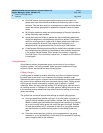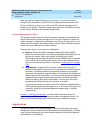
MERLIN LEGEND Communications System Release 5.0
System Manager’s Guide
555-650-118
Issue 1
June 1997
Features and Applications
Page 4-49Features
4
■ Auto Dial buttons require programmed line buttons but are useful for
people who have those buttons available and make many calls to a few
numbers. They are also useful for entering account codes and other dialed
codes and may be appropriate for people who frequently enter the same
codes.
■ MLX display telephone users can take advantage of Directory features for
calling frequently used numbers.
■ Speed dial codes are helpful to people who have nondisplay telephones,
single-line telephones, and telephones with few line buttons. They are also
useful for entering account codes at MLX display telephones, where the
user can choose the Account Code feature from the display, or at
telephones with a programmed button for the Account Code feature.
■ A Last Number Dial button performs like the redial button available on most
home telephones and should be considered for most multiline telephones
in the system. Saved Number Dial is similar, but works as a temporary
Auto Dial button. Once a number is saved on it, it remains until the feature
is used again.
Group Features 4
Group features allow a programmed group of extensions to have a single
extension number. For many purposes, these groups are treated as a single
extension. Below, we discuss the uses of these groups.
Calling Groups 4
A
calling group
is created to receive calls when more than one person answers
the same type of calls and it is not important which person answers a call.
Examples are airline agents, customer service representatives, and telemarketers
who receive direct response calls from customers placing orders. Calling groups
of this type are usually monitored by a special type of operator, a
calling
supervisor
. When too many calls are waiting for a calling group, calls are sent to
an
overflow receiver.
In Release 4.0 and later systems, waiting calls can be sent
to the overflow receiver based how long callers have been waiting or how many
callers are waiting.
The system has numerous features and settings to support calling groups:
■ Hunt type determines whether calls go in a circular pattern (circular hunt
type) to the first available group member, whether calls are distributed
based on which agent has waited the longest since transferring or hanging
up on an incoming calling group call (most idle agent hunt type, Release
5.0 and later systems only), or whether all calls go to one group member
and reach others only when the first person is unavailable (linear hunt
type).
■ Extensions and supervisor positions can be programmed to log group
members in or out (automatically or manually) for the purpose of receiving
calls or stopping calls to the extension.


















